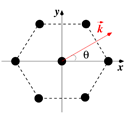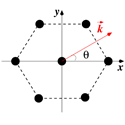Collective action in dusty plasma
Plasmas containing charged microparticles—sometimes called dusty plasmas—offer a way to study complex collective phenomena not usually accessible with conventional ionized media. Two-dimensional microparticle suspensions in plasmas are particularly valuable as they can be easily imaged to capture their full phase-space behavior. Under the right conditions, these particles can arrange themselves into crystalline patterns that melt, recrystallize, and support shock waves and solitons.
Dusty plasmas are known to support in-plane oscillation modes, just like acoustic phonons in regular crystals. Now, Lénaïc Couëdel and co-workers at the Max-Planck Institute for Extraterrestrial Physics in Germany report in Physical Review Letters their observations of an out-of-plane (transverse) phonon mode in a plasma.
The plasma crystal was formed from a suspension of plastic microspheres confined by an discharge above a horizontal metal electrode in argon gas. A horizontal laser sheet illuminated the particle monolayer from the side and a top-view video camera captured the intensity variations as the particles moved up and down in the Gaussian profile of the laser beam. Fourier transforms of the data yield dispersion curves of the in-plane and out-of-plane plasma oscillation modes, which clearly show both acoustic and optical phonons. With this improved visualization method and a more complete catalog of collective behavior in hand, researchers should be able to tackle more subtle interactions in these strongly coupled two-dimensional systems. – David Voss





